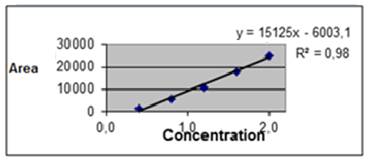|
Introduction
A hair dyeing manufacturer uses henna that can not be sold if the product contains resorcinol, considered as dangerous for the environment. It is also irritant and noxious. The Customs laboratory detected a mass concentration of the order of 0.1%. The powder presents itself like a very complex matrix with a very low- Resorcinol which makes the sampling and the quantification very difficult to analyse.
Substances: Resorcinol
Molecular Weight: 110,11 g/mol
Experimental conditions
The sampling was done with MeOH solvent.
Parameter MS part
The ionization was done in positive mode with an EI source. The detector was a photomultiplier.
Parameter GC part
The material used a Column HP-1(J&W scientific) transplant of geometry L = 30m dc (diameter)= 0.25mm; Film = 0.25µm.
The separation was carried out on a gradient method from 40 up to 300°C and a split ratio of 20 with an output of 1.5mL.min-1.
The first slope 20°C.min-1 and the second slope 2: 10°C.min-1.
Gazeous chromatography method was used in tandem with a mass spectrometer. The matrix was very complex and mainly organic. No analysis method was given by the Customs office. The hypothesis was that the mass concentration of Resorcinol was of 0,1%, for the external standardization to have concentration of Resorcinol in the upper third of standard linear curve. The sampling being a very complex matrix. First a SCAN mode was carried out and on a large gradient for the development. The peak of Resorcinol was identified from the mass spectrum. A SIR Mode was carried out with the fragment 110 to obtain the real peak without any interference of resorcinol. Then a second sampling method was used to refocus the sample through a rotary evaporator.
Results
For the first sample, on the chromatogram obtained the Resorcinol was not detected in SCAN mode (unlike SIR mode); while for the second sample after reconcentration it could be detected with the SCAN mode (due to the reconcentration a coelution with an other compound was observed)
Conclusion
The good working method is with the SIR mode (more sensitive and accurate), with an other slope (lower 10°c.min-1) after had determined the good separations method, try calibration by standard addition and work with a powerful device.
|




